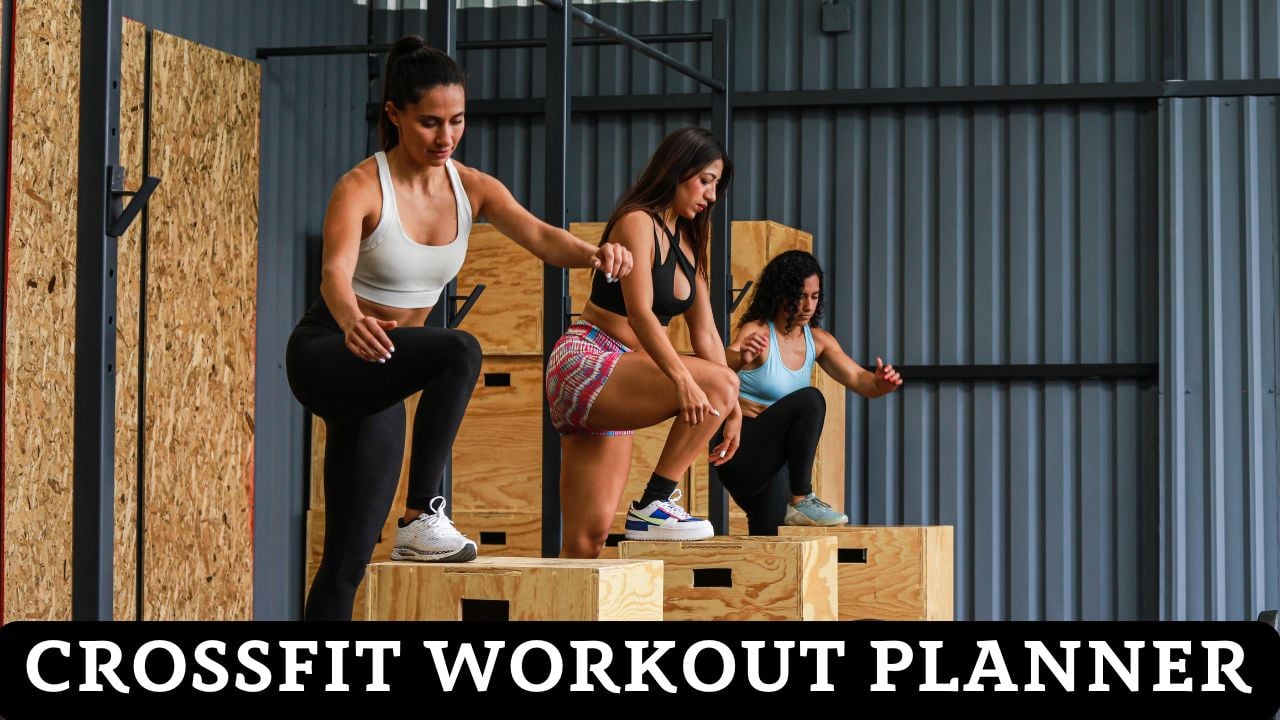CrossFit Workout Planner
Design your personalized CrossFit training program with our AI-powered planner. Get varied, challenging workouts that match your skills, goals, and available equipment.

Customize Your CrossFit Plan
CrossFit Workout Planner
Build functional strength, power, and endurance with our research-backed CrossFit workout planner. According to a systematic review published in Sports Medicine, CrossFit training is associated with improvements in body composition, psycho-physiological parameters, and increased levels of sense of community, satisfaction, and motivation.
The Science Behind CrossFit Training
Functional Fitness Improvements
Research in PubMed Central demonstrates that CrossFit training significantly improves multiple domains of fitness simultaneously, including cardiorespiratory endurance, stamina, strength, flexibility, power, speed, coordination, agility, balance, and accuracy.
Metabolic Impact
Studies show CrossFit’s high-intensity functional training can improve VO2max by 5-10% in just 8-12 weeks while simultaneously increasing anaerobic threshold, making it highly effective for both aerobic and anaerobic adaptations.
Body Composition Changes
According to a study in PubMed Central, participants experienced significant decreases in body fat percentage (2-3% average) and increases in lean muscle mass after 8-12 weeks of CrossFit training, regardless of previous fitness levels.
Psychological Benefits
Research indicates CrossFit participants report significantly higher levels of community belonging, motivation, and exercise adherence compared to traditional gym-goers, leading to better long-term fitness outcomes.
Personalized CrossFit Programs by Experience Level
Beginner CrossFit Program (0-6 months)
3-4 days/week RPE 6-8/10 45-60 minutes- Focus: Building foundational movement patterns
- Strength: Basic barbell movements at moderate weight
- Skill Work: 10-15 minutes on gymnastics fundamentals
- WODs: Shorter duration (8-12 min) with scaled movements
- Recovery: Minimum 1-2 complete rest days per week
EXPERT TIP: Prioritize form over intensity in your first few months. Record yourself to check movement patterns and work with a coach when possible.
Intermediate CrossFit Program (6-18 months)
4-5 days/week RPE 7-9/10 60-75 minutes- Focus: Increasing work capacity and technical proficiency
- Strength: Structured strength cycles (5×5, 3-3-3-3, etc.)
- Skill Work: More complex gymnastics movements
- WODs: Varied durations (8-20 min) with RX movements
- Recovery: Active recovery days with mobility focus
EXPERT TIP: Track your benchmark workouts and retest every 6-8 weeks to measure progress. Identify weaknesses and program 1-2 sessions per week to address them.
Advanced CrossFit Program (18+ months)
5-6 days/week RPE 8-10/10 75-90 minutes- Focus: Sport-specific performance optimization
- Strength: Periodized strength programming with multiple daily sessions
- Skill Work: Advanced gymnastic combinations and transitions
- WODs: Full range of time domains (5-40 min) at RX+ intensity
- Recovery: Programmed deload weeks every 4-6 weeks
EXPERT TIP: At this level, training should be highly specific to your individual weaknesses. Consider working with a coach to conduct a thorough assessment and create a personalized program.
Competitor Program
5-7 days/week Periodized Intensity Multiple sessions/day- Focus: Competition preparation and peak performance
- Strength: Sport-specific strength development with precise loading
- Skill Work: Technical mastery of all movements
- WODs: Competition-specific training with simulated events
- Recovery: Integrated recovery protocols (cold/heat, compression, etc.)
EXPERT TIP: Work with a coach to properly periodize your training year with specific accumulation, intensification, and peaking phases. Carefully track all metrics including HRV and sleep quality.
Sample WOD Templates by Training Goal
Endurance Focus
AMRAP 20:
- 400m Run
- 15 Kettlebell Swings (24/16kg)
- 15 Box Jumps (24/20″)
Target: Aerobic capacity, pacing strategy
Strength Focus
Every 3 min for 5 rounds:
- 5 Front Squats (building in weight)
- Then: EMOM 10 – 3 Push Press + 6 Pull-ups
Target: Force production, strength endurance
Power Focus
5 Rounds for Time:
- 5 Power Cleans (135/95lb)
- 7 Burpee Box Jump-Overs
- 9 Toes-to-Bar
Target: Power output, explosive coordination
Speed Focus
Tabata Intervals (8 rounds of 20s/10s):
- Assault Bike Calories
- Rest 2 min, then Tabata Wall Balls
Target: Anaerobic power, quick recovery
Metabolic Conditioning
For Time (12 min cap):
- 21-15-9 reps of:
- Thrusters (95/65lb)
- Pull-ups
Target: Glycolytic pathway, lactate tolerance
Active Recovery
Not for Time:
- 15 min Mobility Flow
- 5 rounds of 30s light row/30s rest
- 10 min Yoga sequence
Target: Blood flow, mobility, tissue recovery
CrossFit Movement Categories
Research shows that CrossFit’s effectiveness comes from its balanced approach to all ten general physical skills. Below are the core movement categories to include in your programming:
Snatch, Clean & Jerk variants
Squat, Deadlift, Press variants
Pull-ups, Muscle-ups, Handstands
Running, Rowing, Biking, Jump Rope
Kettlebells, Wall Balls, Sleds
Related
- Basketball Calories Burned Calculator
- Badminton Calories Burned Calculator
- Boxing Calories Burned Calculator
- Plank Calories Burned Calculator
- Burpee Calories Burned Calculator
- Crunches Calories Burned Calculator
- Sit-Up Calories Burned
- Zumba Calories Burned Calculator
- Pull Up Calories Burned Calculator
- Push-Up Calories Burned Calculator
- Home Activities Calories Burned Calculator
- Exercise Calories Burned Calculator
- Running Calorie Calculator
- Walking Calorie Burned Calculator
References
- Claudino, J. G., Gabbett, T. J., Bourgeois, F., Souza, H. D., Miranda, R. C., Mezêncio, B., Soncin, R., Cardoso Filho, C. A., Bottaro, M., Hernandez, A. J., Amadio, A. C., & Serrão, J. C. (2018). CrossFit Overview: Systematic Review and Meta-analysis. Sports Medicine – Open, 4(1), 1-14. https://doi.org/10.1186/s40798-018-0124-5
- Wagener, S., Hoppe, M. W., Hotfiel, T., Engelhardt, M., Javanmardi, S., Baumgart, C., & Freiwald, J. (2020). CrossFit® – Development, Benefits and Risks. SportorthopäDie-Sporttraumatologie, 36(3), 241. https://doi.org/10.1016/j.orthtr.2020.07.001
- Schlegel, P. (2020). CrossFit® Training Strategies from the Perspective of Concurrent Training: A Systematic Review. Journal of Sports Science & Medicine, 19(4), 670. https://pmc.ncbi.nlm.nih.gov/articles/PMC7675627/
- Gianzina, Elina & Gianzina, Olga. (2019). The benefits and risks of the high intensity CrossFit training. Sport Sciences for Health. 15. 21-33. 10.1007/s11332-018-0521-7.

Manish is a NASM-certified fitness and nutrition coach with over 10 years of experience in weight lifting and fat loss fitness coaching. He specializes in gym-based training and has a lot of knowledge about exercise, lifting technique, biomechanics, and more.
Through “Fit Life Regime,” he generously shares the insights he’s gained over a decade in the field. His goal is to equip others with the knowledge to start their own fitness journey.
